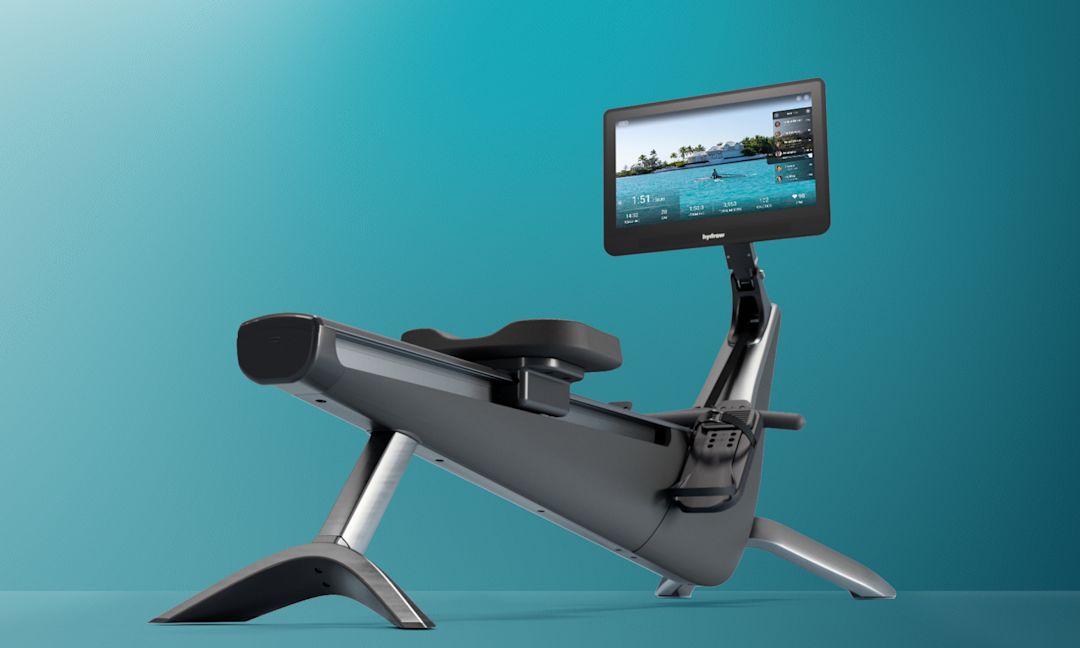What Is Steady-State Cardio?

Cardiovascular workouts are a solid part of any well-rounded exercise routine, whether you’re a fitness enthusiast or just starting to work out regularly. As you familiarize yourself with the different types of cardio workouts at your disposal, you may be considering incorporating steady-state cardio workouts into your fitness arsenal.
But what is steady-state cardio, and why is it worth your time?
In this blog post, we’ll dig into everything you need to know about steady-state cardio, including:
Let’s dive in!
What is steady-state cardio?
Steady-state cardio is a type of cardiovascular exercise that involves working out at a consistent, moderate-intensity pace over an extended period of time with the goal of keeping your heart rate steady.
With this type of cardio workout, you’ll aim to hit between 60% and 70% of your maximum target heart rate—known as your Zone 2 heart rate—in order to burn fat and develop aerobic endurance.
Steady-state cardio workouts tend to last between 20 and 60 minutes and are known as a great way to improve endurance and burn calories.

Holiday savings are here
Bring home our award-winning rowers at the best prices of the year.
What is the difference between steady-state cardio and interval cardio?
The main difference between steady-state cardio and interval cardio training is the variation of intensity.
Steady-state involves constant intensity, while interval training involves bursts of effort followed by less-intense recovery periods.
For example, in a steady-state rowing machine workout, you would set a steady, moderate pace of around 20–24 strokes per minute (SPM), focusing on finding a pace you can sustain over time without exhausting yourself. With an interval training workout, you would spike your heart rate with higher stroke rates (such as 26–30 SPM), then allow it to dip with recovery intervals at lower stroke rates (such as 18–20 SPM).
Moderate-intensity cardio is effective for building endurance and gradually burning calories (more on that later!), while interval training tends to burn more calories in a shorter amount of time and improve your cardiovascular fitness faster due to the spikes in intensity.
Related blog: How Often Should You Exercise?
The benefits of steady-state cardio
There are a ton of perks of incorporating steady-state cardio into your workout routine, including:
Building endurance
Burning fat
Improving heart health
Keeping workouts sustainable
Boosting mental clarity
Let’s dig into each benefit in more detail:
1. Building endurance
Hoping exercising more will help you sustain physical activity for longer? Steady-state cardio is a fantastic pick because it gradually improves your body’s ability to sustain moderate-intensity activity over time. Not only will working out at a steady pace result in your heart and lungs more efficiently delivering oxygen to your muscles, but it also improves your body’s ability to use oxygen and raises your VO2 max (the amount of oxygen your body uses while exercising).
2. Burning fat
Steady-state cardio places your body in a solid position to burn fat. By targeting 60% to 70% of your maximum heart rate in your workout, your body is pushed to use fat as its main fuel source for energy. Additionally, because you are able to work out longer at a steadier pace before exhausting yourself, you can burn more calories in a single workout.
3. Improving heart health
Consistently exercising with steady-state cardio workouts will result in a stronger, healthier heart that pumps blood more efficiently throughout your body. This type of exercise can also help lower your resting heart rate, improve blood circulation, lower your blood pressure, and reduce your LDL (“bad”) cholesterol levels.

Cardio and strength, combined
Burn calories and build muscle with steady, natural movements.
4. Keeping workouts sustainable
Because moderate-intensity cardio workouts tend to be less intense than interval workouts, they are adaptable for all fitness levels and can be easier to perform without burning out or injuring yourself. It also takes less time to recover, allowing you to incorporate these workouts into your fitness routine more frequently without exhausting yourself.
5. Boosting mental clarity
The repetitive, rhythmic nature of steady-state cardio encourages a meditative state, allowing you to focus on your breathing and movements. This can help some people reduce their stress and anxiety.
The potential drawbacks of steady-state cardio
While endurance cardio does feature a host of benefits, it may not be the right pick for everyone depending on your fitness goals and personal preferences. Consider the following cons of steady-state cardio:
Longer workouts
Potential for overuse injuries
Monotonous workouts
Potential for plateaus
Less muscle gain
1. Longer workouts
Because of their more moderate, consistent intensity, steady-state cardio workouts require you to put in more time to get the same results as a higher-intensity workout. If you don’t have a ton of time in your day to dedicate to working out, you may want to mix it up with shorter, higher-intensity exercises.
2. Potential for overuse injuries
Any activity done repetitively over a prolonged period of time has the potential to stress the same muscles, tendons, and joints in your body, raising your risk of overuse injuries such as shin splints, tendinitis, or stress fractures. Taking care to warm up appropriately, listen to your body, and know when to rest will help you avoid these common injuries.
You can work to avoid overuse injuries by picking low-impact cardio options like rowing, which place less stress on your joints.
3. Monotonous workouts
Steady-state cardio workouts will inevitably feel longer, more repetitive, and less dynamic than interval training, which could lead to boredom. If you feel your workouts are getting too monotonous, try to mix it up with different workout types or background music to stay engaged and excited.
4. Potential for plateaus
Challenging your body in different ways is key to improving your gains over time. So, if you are doing the same workouts day in and day out, you may see a plateau at some point as your body adapts to your workout routine. You can avoid plateaus by incorporating different types of cardio exercises into your routine and making sure your workout intensity increases with your body’s growing capacity.
5. Less muscle gain
If gaining muscle is one of your primary fitness goals, steady-state cardio may not deliver the results you’re looking for. Moderate-intensity cardio is more focused on endurance and cardiovascular health, with lower-resistance movements that won’t necessarily generate the muscle tension you need for significant muscle growth.
Related blog: Should You Do Cardio Before or After Weights?
Examples of steady-state cardio workouts
Now that you understand the pros and cons of steady-state workouts, let’s cover through the different types of steady-state cardio workouts you can try out and how long you should work out for on each:
Remember, your workouts should be at a consistent, moderate-intensity pace throughout the entire duration in order to be considered steady-state cardio.
Related blog: Is Rowing Cardio or Strength?
Who should do steady-state cardio?
Wondering if this type of cardio is good for you? Here are some groups that are particularly suited to adopting steady-state cardio into their workout routines:
Workout beginners: This cardio exercise is a gentle way to build cardiovascular fitness without overwhelming intensity, making it accessible if you’re new to exercise.
People recovering from injuries: The moderate, low-impact nature of steady-state cardio allows you to move without excessively straining injured areas.
Older adults: As a low-impact cardio workout, steady-state is perfect for older adults who want to maintain their heart health and mobility without placing too much stress on their bodies.
Endurance athletes: If you’re training for a long-distance event like a marathon or triathlon, steady-state cardio will help you build up the aerobic capacity and stamina you need.
People looking to lose weight: Because steady-state cardio is an effective way to burn calories and fat, it can help you with weight management.
Tips for incorporating steady-state cardio into your workout routine
Think steady-state cardio is right for you? Fantastic! Use these tips to safely and effectively bring this workout type into the fold:
1. Figure out your target steady-state cardio heart rate
The most important step when starting steady-state cardio workouts is figuring out what your heart rate should be when working out to get in that magic aerobic Zone 2 heart rate zone. Start by calculating your maximum heart rate, which can roughly be calculated by subtracting your age from 220.
So, if you are 40 years old, your maximum heart rate would be around 180 beats per minute (BPM).
Then, to figure out where your range lies for steady-state cardio, you’d calculate 60% to 70% of that number—in this case, around 108 to 126 BPM.
2. Monitor your heart rate and intensity
Now that you know where your target heart rate is, you’ll need a way to monitor this during your workouts to ensure you’re at the right intensity. Use a wearable heart rate monitor such as a chest strap or wrist tracker to see real-time heart data throughout your workout. If you are using a piece of fitness equipment, some models even sync with your smartwatch or fitness tracker to display your metrics right in front of you.
3. Start slow
Particularly if you’re new to fitness or returning after some time off, you should aim to build your endurance gradually without overwhelming your muscles or heart. Not only does this reduce the risk of injury and help you avoid burnout, but it will also help you form a longer-term habit by featuring exercise that actually feels good.
4. Choose activities you enjoy
No one likes to drag themselves to a workout kicking and screaming. By experimenting with different types of steady-state cardio, you can find workout types you actually enjoy, increasing the chances that you’ll stick with them over time.

Explore Hydrow’s library of 5,000+ rowing, circuit training, yoga, Pilates, and mobility workouts.
5. Combine with other training
You also don’t need to only do steady-state cardio! Mix up your workouts between steady-state and interval training—and even strength training!—for a more holistic, well-rounded fitness routine that will leave you feeling boredom-free.
6. Listen to your body
As always, it’s important to listen to your body when working out. If you’re feeling overtired or if a certain part of your body is hurting more than usual, it’s worth taking a break to avoid injury and burnout. Don’t feel discouraged if you need to take some time to recover—even with steady-state cardio, breaks are required in order to stay safe.
Try steady-state cardio rowing workouts with Hydrow
As you can see, steady-state cardio is a fantastic way to get in some exercise. If you’re looking for a way to incorporate this workout type into your fitness routine, consider buying a rowing machine. Rowing activates 86% of your muscles with every stroke, making it one of the most efficient ways to build total-body strength. In just 20 minutes on a rowing machine, you can get a full-body workout that boosts energy, builds endurance, and helps you move better—on and off the rower.
And with Hydrow, it’s easier than ever to stay consistent. No commute. No waiting for machines. Just expert-led workouts you can do from home, whenever it works for you. Choose from rowing, strength training, mobility, yoga, Pilates, and circuit training workouts, all designed to help you move better and feel stronger, long-term.
Our workouts are filmed on location in stunning waterways around the world and led by world-class Athletes who coach you through every stroke and rep. And with over 5,000 workouts ranging from beginner to advanced, it’s easy to keep progressing no matter your level.
Every movement adds up. Start building strength that lasts with Hydrow.

Real strength keeps moving
Learn how working out with Hydrow can help support a fuller, more active life.











